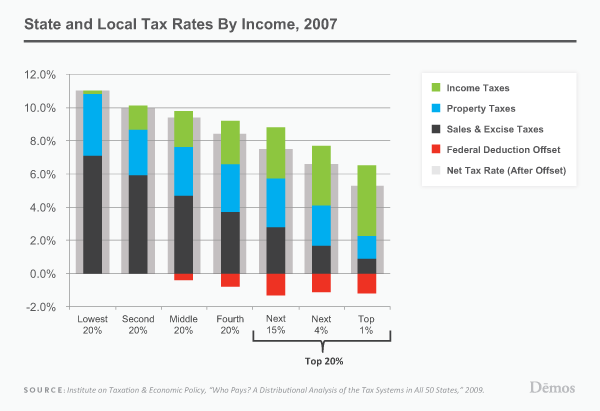This piece is the second in a six-part series on taxation, and a joint project by The American Prospect and its publishing partner, Demos.
 "Tax fairness" is defined very differently by Americans from various walks of life. Despite this divide, there is a substantial shared vision: A majority of Americans believe that the government should be doing more to help people, and the vast majority believe that wealthier Americans should be the ones paying higher taxes to support those priorities.
"Tax fairness" is defined very differently by Americans from various walks of life. Despite this divide, there is a substantial shared vision: A majority of Americans believe that the government should be doing more to help people, and the vast majority believe that wealthier Americans should be the ones paying higher taxes to support those priorities.
If that is the case, why do we have a state and local tax system that is the polar opposite of those beliefs, one where the better-off pay about half as much in taxes as the less-well-off? This inequity both contradicts our country's shared beliefs on tax fairness and is the major cause behind the critical lack of state and local investment in social capital that I wrote about in my last piece. We need to correct this inequality immediately if we are going to maintain needed levels of investment in social capital in the face of a rapidly aging society that will require progressively larger expenditures in the next two decades.
So, just how unequal are state and local taxes? In its comprehensive 2009 report, the Institute on Taxation and Economic Policy analyzed the tax systems of all 50 states and major localities and found that, as a whole, state and local tax systems are extremely regressive. As the graphic shows, the poorest 20 percent of Americans pay, on average, a combined state and local tax rate of 11 percent, while the wealthiest 1 percent pay less than half that: 5.3 percent. This disparity is even more pronounced in the most regressive states: in Washington state, which has the most regressive tax system, the poorest 20 percent pay an average tax rate of 17.3 percent while the top 1 percent pay just 2.3 percent.

Why are state and local tax systems so regressive? The primary culprits are sales and excise taxes. Sales taxes are regressive because they're flat taxes on consumption, i.e. everyone, rich and poor, pays the same rate on their purchases. And because wealthier Americans spend a far lower percentage of their income on consumption, they pay a much lower effective tax rate. Many states exempt certain essential goods-particularly groceries-from sales taxes, but in many of the states with the most regressive tax systems, including South Dakota, Tennessee, and Alabama, groceries are taxed as well, imposing an even higher tax burden on the poor. Even more regressive, however, are excise taxes, which are additional flat consumption taxes on a special set of goods, most commonly gasoline, alcohol, and tobacco products. Because, among other reasons, the amount of these goods that each person can consume has a very natural or biological limit, Americans on the lower end of the income scale spend a much larger portion of their income than those on the higher end, and thus pay a higher effective tax rate as well.
The cost of these radically unfair tax regimes to our states and localities is staggering. In fiscal year 2009, according to the census's 2009 survey of state and local finances, the total state and local individual tax revenue collected was $1.12 trillion. According to ITEP's figures, the average total state and local tax rate was 9.2 percent. If states and localities made their tax systems fairer so that everyone just paid the same tax rate as the poor-11 percent-states and localities would have taken in an extra $220 billion in revenue in 2009, more than enough to fill the aggregate state budget shortfalls of $110 billion in that year, and even enough to fill the larger FY 2010 deficits of $191 billion, in total. To give another example of what this revenue could do, consider that states collected just $99 billion in tuition and fees in 2009 from students enrolled in higher education; thus, creating "fairer" tax systems would generate enough revenue to provide free tuition at all public higher-education institutions more than twice over. I said "fairer" tax systems because the $220 billion in extra revenue would be generated just by making state and local taxes truly flat; many (myself included) might argue for progressive state and local taxation, a policy that most Americans would support as well, if the Pew poll cited above is any guide.
State and local taxes fund many of the most critical investments in our country's future, including education, infrastructure, and housing; investments that all Americans, rich or poor, rely on. And right now, wealthier Americans, because of the unfairness of state and local tax systems, aren't paying close to their fair share of the costs of those investments. How can we remedy this? Reforming the most regressive taxes-sales and excise taxes-seems like the logical place to start. The end result of any tax reform, however, needs to be revenue-positive reform that both lowers the tax rates of lower- and middle-income families and raises those of the well-off, resulting in a progressive, not regressive, system overall. Whether we get there through lower sales and excise taxes, increased carve-outs of those taxes for necessities like clothing and medication, or higher and more progressive income taxes can and should be left up to the creativity of our states and localities.

and join the Demos mailing list.



